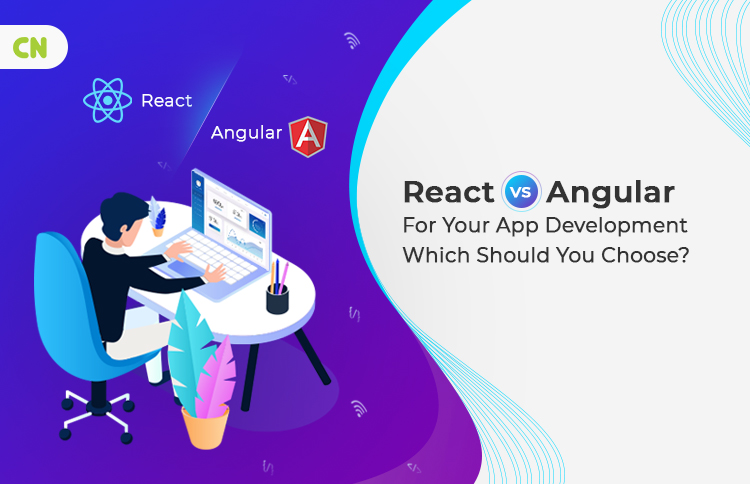React vs. Angular: Which works better for Frontend Development?
Table of Contents
If you want an application for web or mobile with a smooth UI and minimal code, consider using either Angular or React. The increasing dominance of millennials in the tech domain has increased the popularity of these frameworks. Furthermore, these frontend frameworks are used by some of the biggest brands and apps you use online daily.
Despite serving similar functions, they have massive differences that you should know about. This article provides deeper insight into the differences between React.js and Angular, focusing on core features, ecosystems, tools, and more. These insights will help you decide on your next application development project.
General Information
- Created by and releasing year: Meta (earlier known as Facebook) developed and released React in 2013. React was introduced to address the company’s requirement to create high-performance user interfaces. On the other hand, Google developed and released AngularJS or Angular 1 in 2010. In 2016, it was completely transformed using TypeScript (or Angular 2) to address its predecessor’s limitations and adapt to the evolving app development landscape.
- Base programming language: React is based on JavaScript (ECMAScript 6 or ES6). Hence, it uses the language’s latest features. However, Angular is based on TypeScript (JavaScript’s superset developed by Microsoft). TypeScript offers object-oriented programming (OOP) features and robust typing. This makes Angular a favorable option for complicated and larger projects.
- Type: React is an open-source frontend JavaScript library that helps frontend developers create component-based user interfaces. Comparatively, Angular is an open-source single-page TypeScript-based application framework for developing client-side applications.
- Learning curve: React has a relatively moderate learning curve compared to Angular. Therefore, novice developers familiar with JavaScript can quickly grasp the basics. However, mastering its ecosystem and core concepts may take time and practice. Comparatively, Angular’s architectural complexity, extensive feature set, and reliance on TypeScript steepens the learning curve for beginners.
- Supporting languages: React supports JavaScript as the primary language. It also supports JSX (JavaScript XML), which enables developers to write HTML-like code directly within JavaScript files. Angular primarily supports TypeScript, but it also supports Dart and JavaScript.
- Suitable projects: React’s component-based architecture makes it ideal for developing single-page applications (SPAs) and mobile apps (with React Native). Conversely, Angular is a go-to choice for enterprise applications and large-scale projects requiring complex data management, form handling, routing, and other robust features.
Market Share, Usage, and Trends
React and Angular have gained high popularity among developers and businesses for their efficient results. However, React has seen a significant rise in popularity and adoption. According to Github, React has a score of 216k stars, while Angular has 92.9k stars. Furthermore, according to the Stack Overflow Developer Survey 2023, React is at the top of the list of most preferred web development frameworks for professional developers, while Angular ranks fourth. Around 42.87% of experienced developers use React.js, while only 19.89% use Angular. Furthermore, according to a Statista 2023 report, 40.58% of worldwide developers prefer using React, while only 17.46% prefer using Angular. Therefore, React is very popular among developers worldwide.
Community Support and Resources
Community engagement
React has a community comprising over a million developers. This community actively contributes to an ecosystem of frameworks, libraries, and tools. Each developer in the community follows a strict code of conduct before contributing to forums like DEV, Hashnode, Reactiflux, Reddit, and Stack Overflow. Therefore, the rich community of React is the key to making the frontend framework so relevant in today’s technologically advanced world.
The rich Angular community, comprising diverse developers worldwide, contributes to evolving Angular as a robust and adaptable framework. Besides their comprehensive documentation, experienced developers often provide books, blogs, podcasts, online and onsite training, workshops, and more. The best part is that you can access all these from a single platform. The Angular community conducts conferences and meetups like the NG-CONF 2023 for better collaboration, learning, and networking. Furthermore, developers participate in online forums like GitHub, Reddit, and Stack Overflow, submitting bug reports, feature requests, and pull requests for code changes. Furthermore, they share knowledge, solve problems, and create a vibrant future for Angular.
Documentation and learning resources
React has easy-to-understand and up-to-date documentation, including interactive code sandboxes and practical examples. These inclusive resources enable developers to learn and practice directly from the browser, removing the necessity of setting up projects locally. Therefore, React promotes interactive learning, especially for amateurs.
Angular also offers community forums, comprehensive documentation, and tutorials. The Angular documentation provides a structured learning path to help novice developers understand its opinionated application development approach. Furthermore, Angular collaborated with an online interactive code-learning platform, SoloLearn, to provide a free introductory course on Angular.
Core Concepts
- Architecture: React has a component-based architecture. Hence, dedicated React.js developers encapsulated components with self-management capacities to develop dynamic UIs. Comparatively, Angular has a Model-View-Controller (MVC) architecture comprising well-defined structures, from controllers to services, to create an application’s different layers.
- Components: React stands upon class-based, functional, and other modular and reusable components. Function components have gained greater popularity since React hooks allow them to manage state and side effects. In Angular, components form part of a hierarchy and are mainly used for developing and specifying elements and logic on the page. Furthermore, developers can couple them with templates to define views.
- Code structure: React offers a flexible code structure that enables developers to organize files and components as required. Yet, React projects require additional configuration and structuring for state management and routing. Conversely, Angular follows a more rigid and standardized file structure comprising predefined places for various components, models, and services. This structure offers consistency to larger teams.
- Data binding: React uses one-way data binding to update UI elements on the model state. However, frontend programmers can use Redux and similar state management libraries for complex state handling. Comparatively, Angular uses both one and two-way data binding. This double approach ensures a seamless model and view synchronization. Furthermore, it simplifies the management of form handling and other interactive elements.
- Dependency injection: React does not have a built-in dependency injection system. However, developers can achieve dependency injection by using contexts or higher-order components (HOCs). Angular has a powerful dependency injection system. This system decouples components from their dependencies, making unit testing easier and modular code writing more efficient.
- Directives: React follows the approach of writing conditionals and logic directly in the JSX as a measure of using directives. Angular’s directives are divided into attribute, custom, and structural. Angular directives enable attaching behavior to elements in the DOM.
- DOM type: React uses a virtual DOM, while Angular uses the real DOM. React’s virtual DOM is a lightweight copy of its actual DOM. The virtual DOM updates only the modified parts on the real DOM for performance optimization. However, Angular updates the entire tree structure of HTML tags during modifications on the real DOM and uses change detection for optimized performance.
- Syntax: React’s syntax comprises a blend of JavaScript and JSX. Hence, React developers can follow an approach similar to HTML for creating UI elements. On the other hand, Angular’s syntax relies heavily on TypeScript. Plus, it introduces numerous decorators and specific syntax for component definitions and data binding.
- UI rendering: Both React and Angular support client and server-side rendering. Yet React binds UI in the plain object or property level while Angular directly links state to the UI.
Ecosystem and Tools
- Building and Bundling Tools: React uses Webpack configured with Create React App for module bundling and streamlined application setup. Conversely, Angular internally uses Webpack integrated into the Angular CLI. This approach removes manual configuration complexities and enables simplified application building and bundling.
- Development and Debugging Tools: React.js uses React DevTools, available for Chrome and Firefox, to receive insights into hooks, props, state, and other parts of the React component tree. On the other hand, Angular utilizes Angular DevTools, available for Chrome and Firefox, to enable developers to leverage debugging and profiling capabilities.
- Mobile Application Development: React.js provides React Native – a popular mobile app development framework. Using it, developers can create native mobile applications. Comparatively, Angular can be used with the Ionic framework and NativeScript to develop hybrid and native mobile applications.
- Project initialization and scaffolding: React.js uses the Create React App to abstract webpack and Babel configurations. This abstraction provides a simplified setup process and a ready-to-use development environment for React projects. On the contrary, Angular uses the Angular CLI (command line interface) to initialize and manage Angular projects. This official tool streamlines new mobile and web application development projects and Angular entity additions like components and services.
- Routing and navigation: ReactJS uses React Router, a standard routing library, for dynamic routing and high customization. Moreover, it seamlessly integrates into React applications. Comparatively, Angular uses Angular Router, a feature-rich and robust navigation and routing solution, to implement guards, lazy loading, nested routes, and other advanced routing features.
- Server-side rendering: React uses Next.js to develop server-side rendering-backed applications for improved performance and SEO. Comparatively, Angular uses its built-in server-side rendering solution, Angular Universal, to render applications on the server.
- State management: React uses Context API, a new feature added in React 16.3, to pass data through the component tree. Furthermore, you do not need to pass props manually at every level. On the other hand, Angular uses its core features – Dependency Injection and services for cross-component communication and state management.
- Testing utilities: React.js uses Jest, a built-in test runner for unit and snapshot testing. Furthermore, it uses Enzyme and React Testing Library for testing components. However, Angular uses Jasmine as the primary testing framework, Karma as a test runner, and Protractor for end-to-end testing.
- Type checking: React.js uses PropTypes to type-check the props passed to React components. Furthermore, it optionally uses TypeScript for enhanced type-checking and development experience. On the other hand, Angular uses TypeScript for strong typing and object-oriented features.
- UI component libraries: React uses Material-UI or MUI to style components according to Material Design. Furthermore, it uses React Bootstrap for Bootstrap integration to use a diverse set of responsive UI components. On the other hand, Angular uses Angular Material, ng-bootstrap, and PrimeNG as its comprehensive UI component library, offering rich UI components.
You May Also Read: State Management in Front-end Development: Redux vs Context API
Third-party Integration
- Animation Libraries: React uses React Motion and React Spring, two powerful libraries for animation development. React Motion provides a range of animation utilities, while React Spring focuses on spring animations for natural motion. On the other hand, Angular Animations leverages to create and control powerful animations in applications.
- Data Visualization and Charting: React uses three comprehensive data visualization libraries – Recharts, React-vis, and Victory to create customizable and responsive charts for better data representation. However, Angular uses angular-google-charts, an open-source Angular wrapper, to integrate feature-rich Google Chart visualization in Angular applications. Furthermore, it uses ngx-charts to utilize its wide range of customizable and integratable chart options.
- Form Handling: React.js uses Formik and react-hook-form for form development and management using little to no code. On the other hand, Angular uses @angular/forms, its built-in core form library, for reactive and template-driven forms approach. Furthermore, it uses ngx-formly, a dynamic JSON-powered form library, for a high level of abstraction.
- HTTP Client for API Calls: React.js uses Axios to perform HTTP requests in React applications and Fetch API to handle HTTP calls in modern browsers natively. Conversely, Angular uses Angular HttpClient, a robust HTTP client supporting request/response interception, strong typing, and other features.
- Internationalization and Localization: React.js uses react-i18next and react-intl for their powerful and comprehensive internalization capabilities. Angular uses Angular i18n as its native internalization solution. However, it also uses ngx-translate, a third-party library, for more flexible localization options.
- Static site generation: React.js uses Gatsby, which optimizes static site generation and performance. Angular, on the other hand, uses Scully to pre-render applications into static sites efficiently.
- State Management: React uses Redux, a centralized state management library, for managing Flux architecture-based application state. Furthermore, it also integrates with MobX to use its observable-based API for simpler and scalable state management. Conversely, Angular uses NgRx, a Redux pattern-based framework, for side effects and state management. It also uses RxJS for reactive programming and efficiently handling asynchronous data streams.
Read more : Why choose React.js for Interactive UI Development?
Conclusion
In today’s web development landscape, React and Angular are powerful frontend technologies with unique strengths that cater to different project needs. React, renowned for its simplicity and flexibility, is ideal for creating dynamic user interfaces and is versatile in integrating with other tools. Conversely, Angular offers a comprehensive framework with robust features that make it suitable for building complex, large-scale applications. Choosing between these technologies depends on specific project requirements, developer expertise, and desired scalability. With the evolution of the web development landscape, React and Angular have proven their enduring relevance and utility in the tech world by adapting to the changing requirements of the industry.














